Pantages Theatre (Hollywood)
.jpg) |
|
| (2019)* – Close-up view showing the front of the Pantages Theatre and its Art Deco intricate designs. Photo by Howard Gray |
Historical Notes Opened in the summer of 1930, The Pantages Theatre in Hollywood has become one of Los Angeles’ most enduring and recognizable cultural landmarks. |
Early Views and History
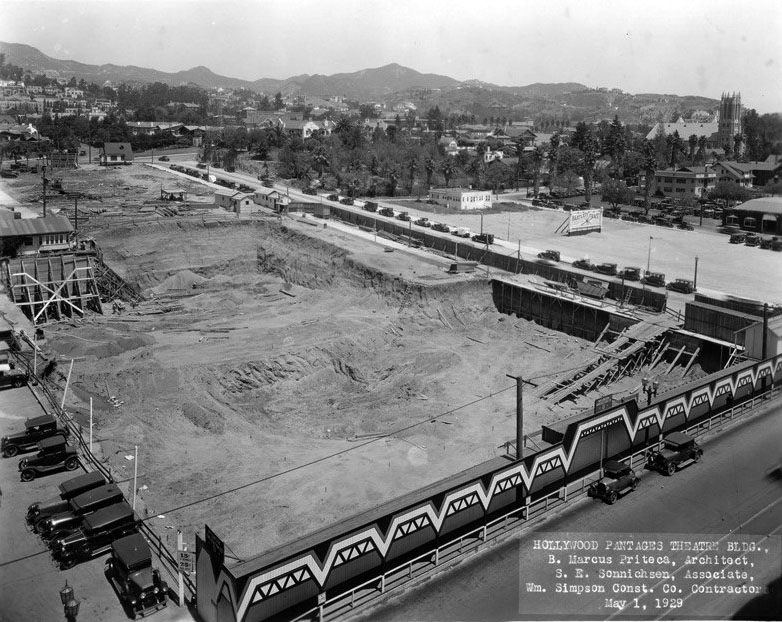 |
|
| (1929)^ – View looking northeast showing the construction site for the Hollywood Pantages Theatre, located on the northwest corner of Hollywood Boulevard and Argyle Avenue. The tallest peak in the distance is Mt. Hollywood, near where the Griffith Park Observatory would be built in 1933. |
Historical Notes The Pantages Theatre was constructed between 1929 and 1930 under the leadership of Alexander Pantages, and cost $1.25 million. |
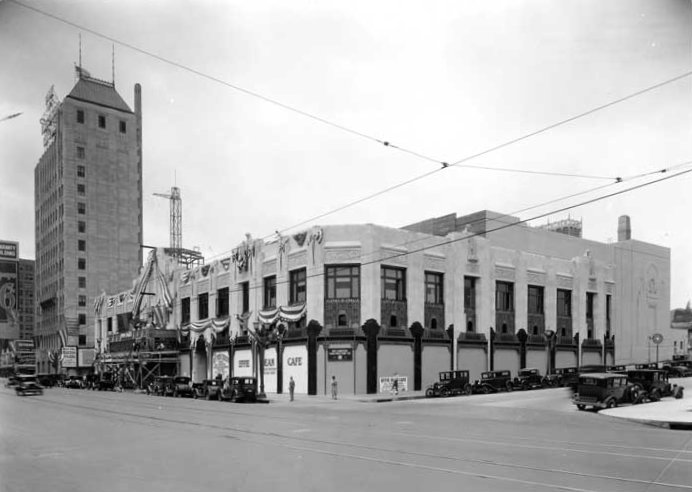 |
|
| (1930)* - View of the Pantages Theater still under construction in 1930, located on the northwest corner of Hollywood Boulevard and Argyle Avenue. The tall building to the west is the Equitable Building, located on the northeast corner of Hollywood and Vine. |
Historical Notes The Pantages Theatre, formerly known as RKO Pantages Theatre was the last theater built by the vaudeville impresario Alexander Pantages. The palatial Art Deco theater opened on June 4, 1930, as part of the Pantages Theatre Circuit. |
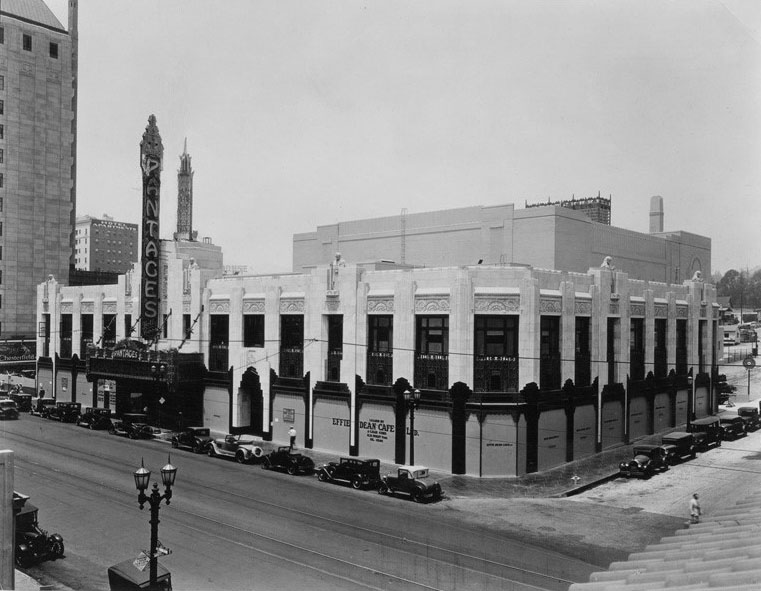 |
|
| (1930)* - View looking at the northwest corner of Hollywod and Argyle showing the newly completed Pantages Theatre. |
Historical Notes The original plans for the Pantages were for a 12-story building: 2 floors dedicated to theater and 10 floors of office space. Completion of the 10 upper floors was halted due to the 1929 stock market crash during construction. |
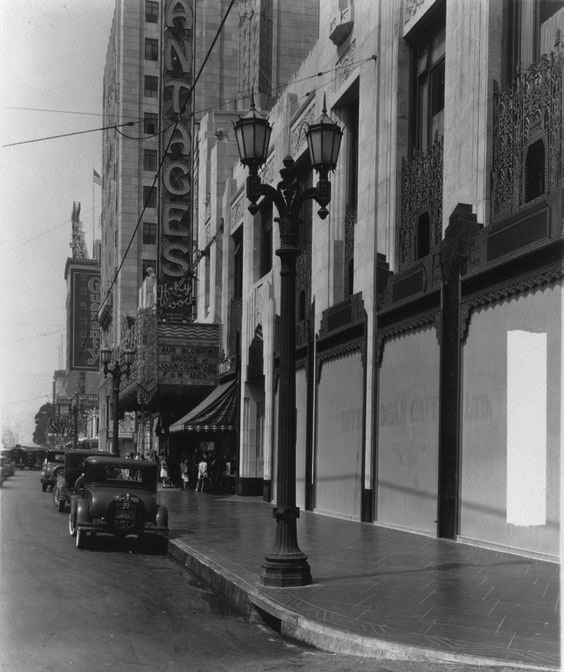 |
|
| (1930s)^v^ - Street view looking west on Hollywood Boulevard from Argyle Avenue showing the Pantages Theatre.Note the ornate streetlights that lined the street in front of the Pantages. These were commonly known as Metropolitan Electroliers and could be found throughout Hollywood in the 1930s. |
Historical Notes The Pantages Theatre can hold claim to two “lasts”: the last movie palace to be built in Hollywood and the last venue erected by vaudeville circuit owner, Alexander Pantages. |
 |
|
| (1930)+#+ – View showing the glitter and lights of the Pantages Theatre on what appears to be opening night. We’re looking southwest at the back of the theatre with cars parked along Argyle Avenue. Note the Art-Deco bas relief designs on the side of the building. |
Historical Notes The Pantages opened on June 4th, 1930 with MGM's “The Floradora Girl” starring Marion Davies. |
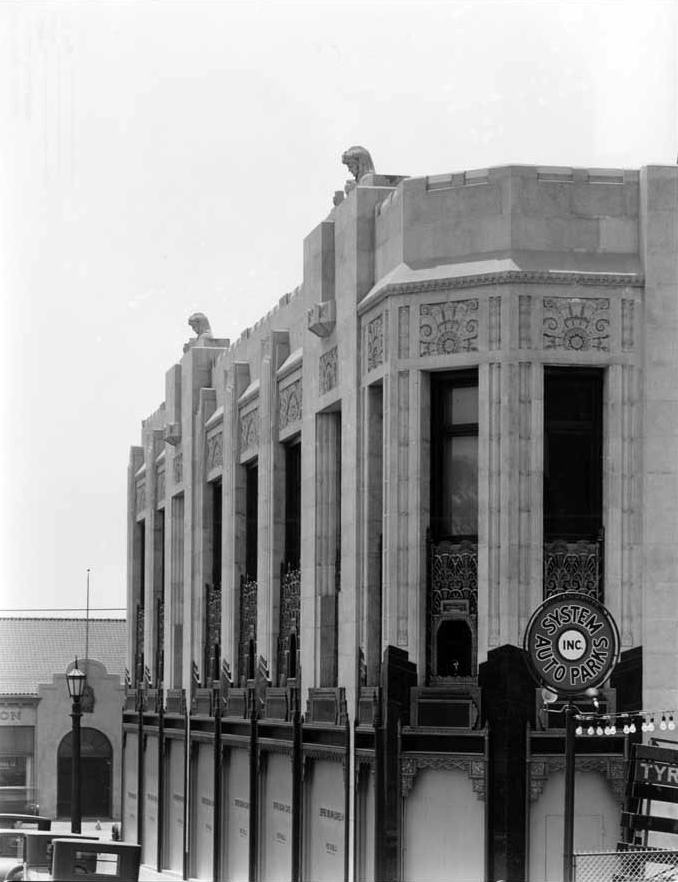 |
|
| (ca. 1930)* – Profile view looking toward Hollywood Boulevard at Argyle Avenue showing some of the Art Deco designs on the side of the Pantages building. Note the statues along the roof line. |
Historical Notes Designed by B. Marcus Priteca at the epitome of the Art Deco era, from sidewalk to stage, the Pantages dazzles theater-goers with chevrons, zigzags, starbrusts, and exotic figures.^ |
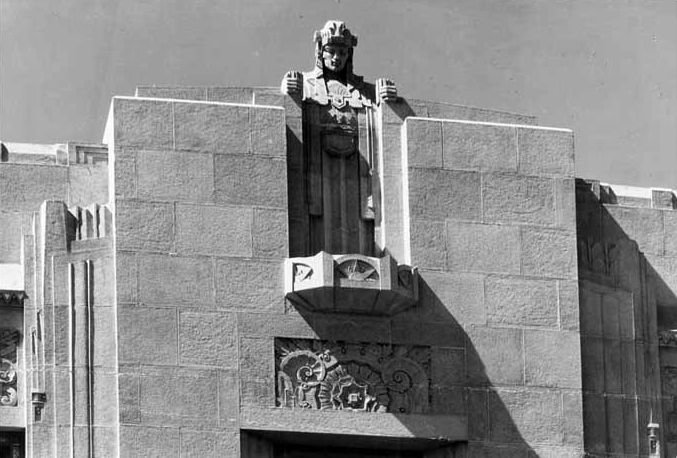 |
|
| (ca. 1930)* - Close-up view of one of the many statues that run along the Pantages’ roofline. They’re of a Mayan man with headdress. |
 |
|
| (1930)* - Exterior view of the Pantages Theatre located at 6233 Hollywood Boulevard shortly after it opened. Click HERE to see contemporary view. |
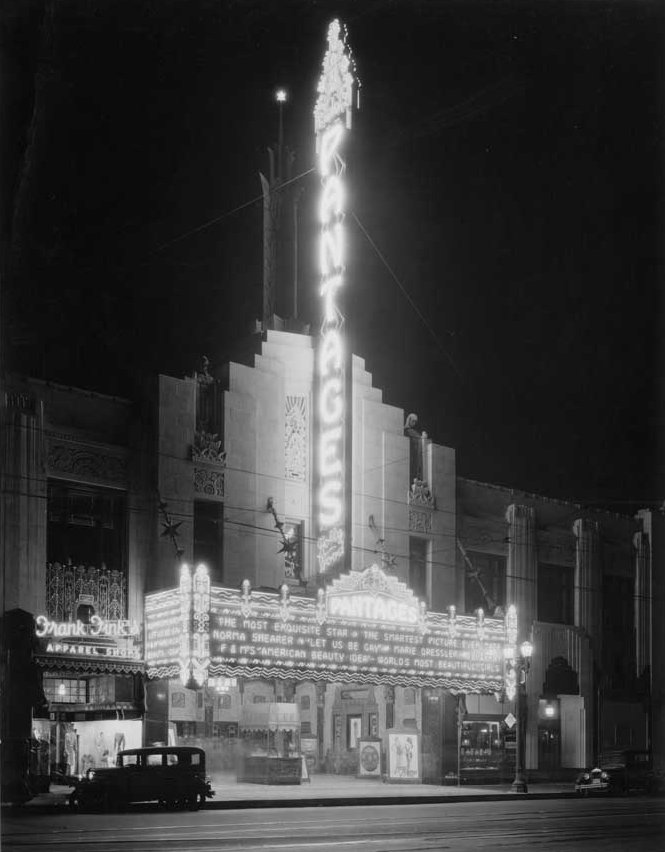 |
|
| (ca. 1930)* - Nighttime view of the front entrance to the Pantages Theater. Frank Fink's Apparel Shop is seen on the left. |
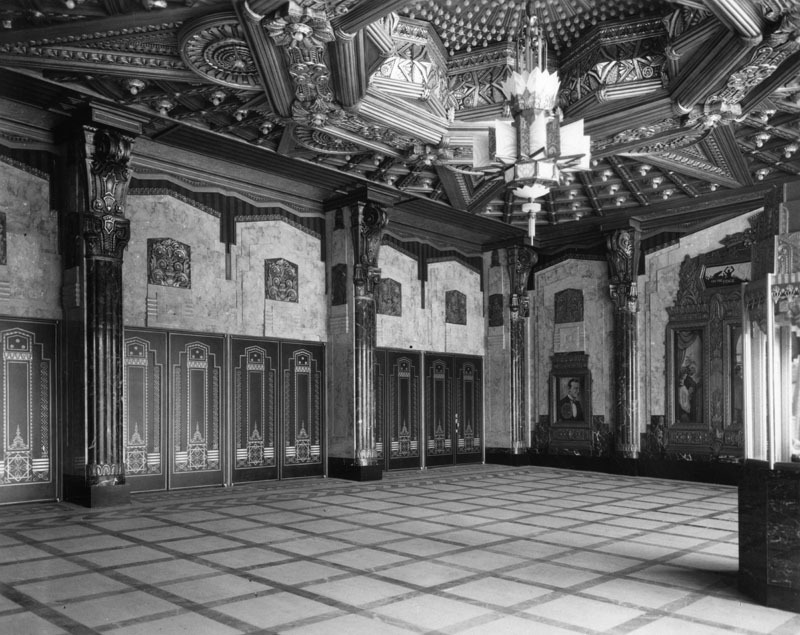 |
|
| (1930)* - View of the foyer at the Pantages Theatre with a close look at the ceiling. |
Historical Notes Alexander Pantages sold the Hollywood landmark in 1932 to Fox West Coast Theaters. In 1949, Howard Hughes acquired the Pantages for his RKO Theatre Circuit and moved his personal offices to the building's second floor. From 1949 through 1959, the theatre hosted the American motion picture industry's annual Academy Award Ceremonies. |
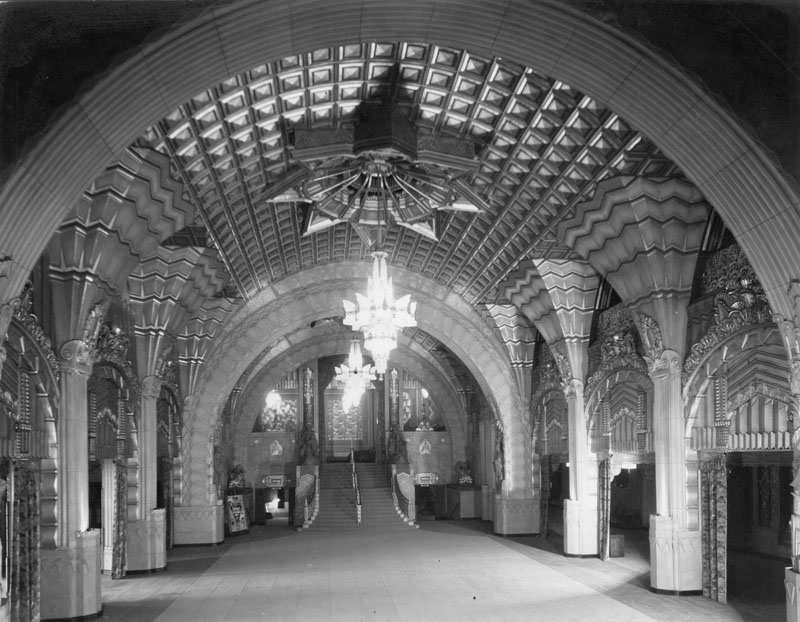 |
|
| (ca. 1930)* - Interior view of the Pantages Theatre. Designed by architect B. Marcus Priteca it is perhaps the most impressive of any Los Angeles theatre. |
Historical Notes The grand lobby is a magnificent poly-chromatic fan-vaulted space, that is 110 feet wide and 60 feet deep. It is decorated in a zigzag geometric design in gold and henna shades. The entire area was illuminated by three huge Moderne frosted glass chandeliers hanging from three star-shaped domes. |
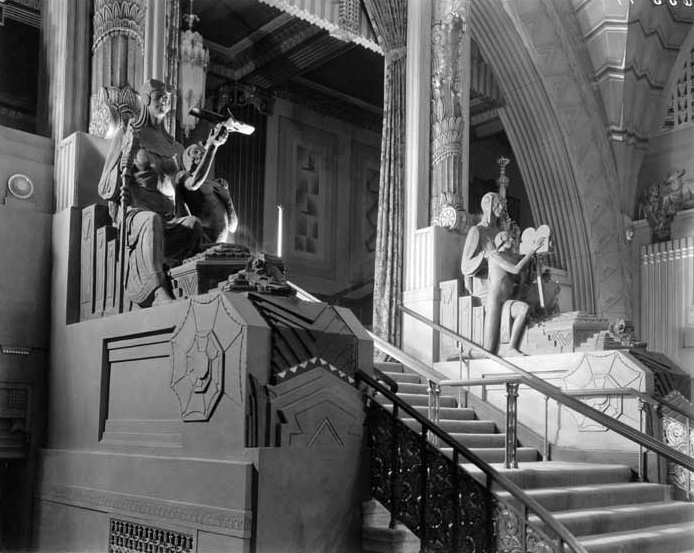 |
|
| (ca. 1930)^*# - View showing one of the two Art-Deco staircases decorated with Art Deco style statues. |
Historical Notes At each end of the grand lobby is a 20 feet wide stairway, lined with vaguely Egyptian and Assyro-Babylonian styled statues, one of which depicts in an Art Deco style, a camera crew filming. |
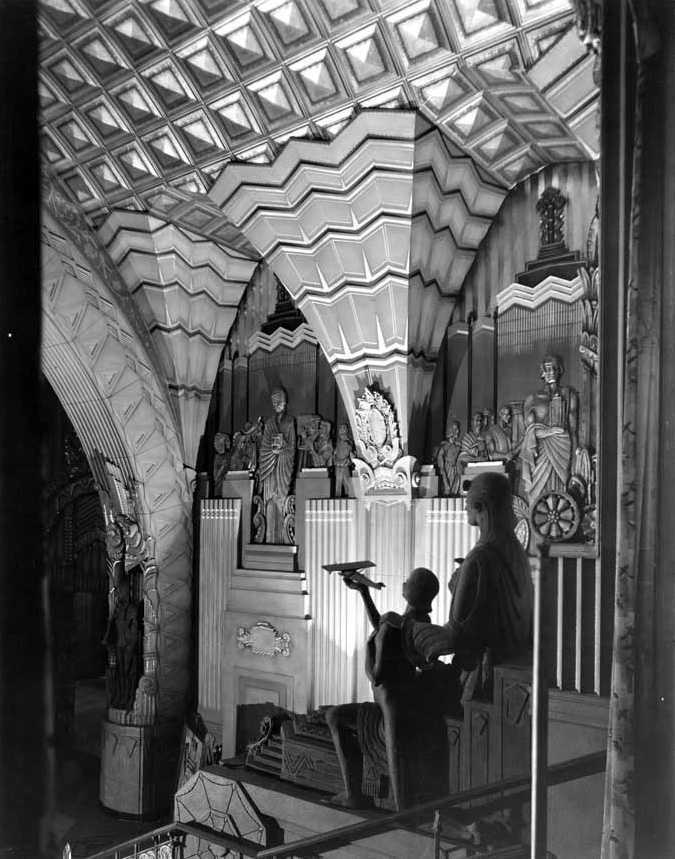 |
|
| (ca. 1930)^*# - View looking down into the grand lobby from top of staircase showing the magnificent zigzag geometric design of the pillars. |
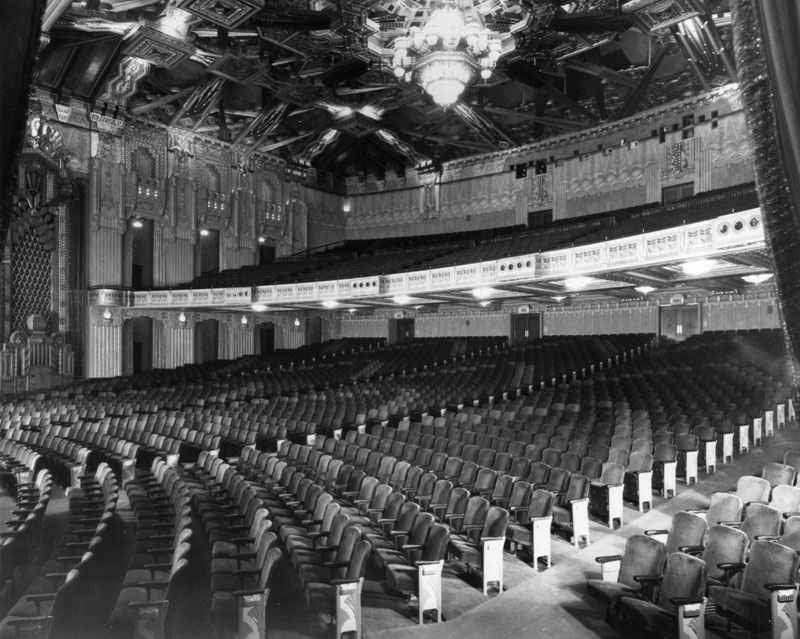 |
|
| (1930)* - View of the auditorium interior of the Pantages Theatre. |
Historical Notes The auditorium was designed to seat 3,212, but it opened with extra legroom and wider seats to give more comfort for its 2,812 patrons. |
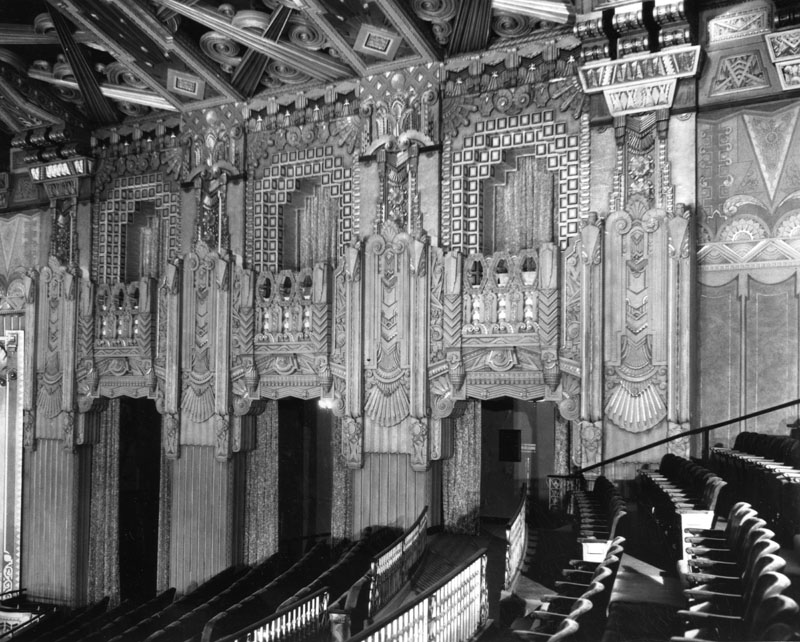 |
|
| (1930)* - A partial view of the balcony seats inside the Pantages Theatre. Note the details of the ornamental Art Deco designs on the wall. |
Historical Notes The crowning beauty of the dazzling Art Deco style decorations which cover almost every inch of the theatre interior, by interior designer/muralist Anthony B. Heinsbergen, is the double ceiling made in a series of ‘busy’ fretwork sunray effects which converge from the center, from which is hung a tremendous frosted glass and bronze chandelier. |
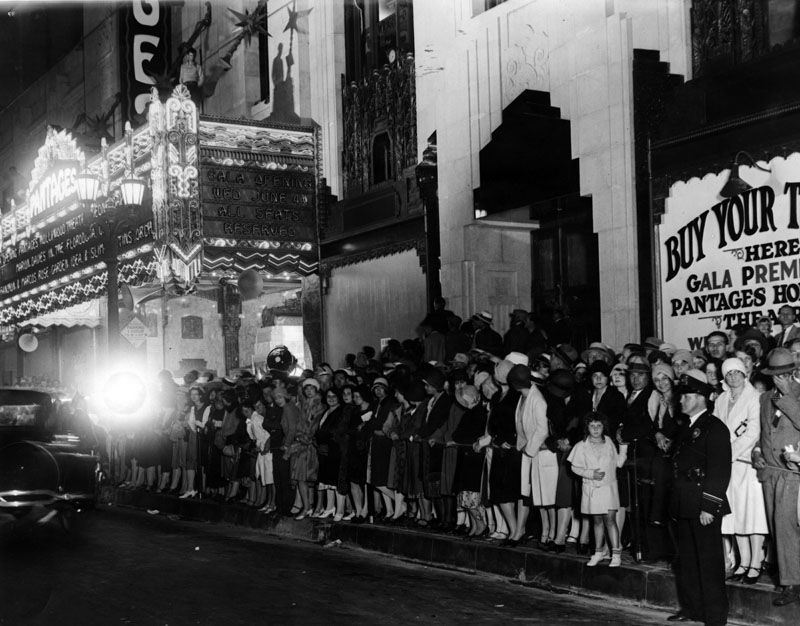 |
|
| (1930)* - Close-up view of fans awaiting the arrival of celebrities attending gala opening premiere of "Florodora Girl", starring Marion Davies. |
Historical Notes The Pantages Theatre was one of the first movie houses to be built after the advent of talking pictures and once boasted the most elaborate sound system in the world. It opened with Marion Davies in “The Floradora Girl” on screen, and “The Rose Garden Idea” a Franchon & Marco stage revue. |
 |
|
| (ca. 1930)* - Night view of the Pantages Theater featuring a Clara Bow movie. |
Historical Notes The Pantages Theater continued to be a major venue for road show movies into the 1970s. From 1965, it was operated by Pacific Theatres. It closed as a movie theater in January, 1977, and re-opened the following month with Bubbling Brown Sugar, the first of the many stage productions that have since become its regular fare. |
 |
|
| (1931)* - The lighted marquee at night of the Pantages Theatre. The main feature is 'Tarnished Lady' with Tallulah Bankhead and Clive Brook. |
Historical Notes The 1930 Pantages Theatre can hold claim to two “lasts”: the last movie palace to be built in Hollywood and the last venue erected by vaudeville circuit owner, Alexander Pantages. Designed by B. Marcus Priteca at the epitome of the Art Deco era, from sidewalk to stage, the Pantages dazzles theater-goers with chevrons, zigzags, starbrusts, and exotic figures. |
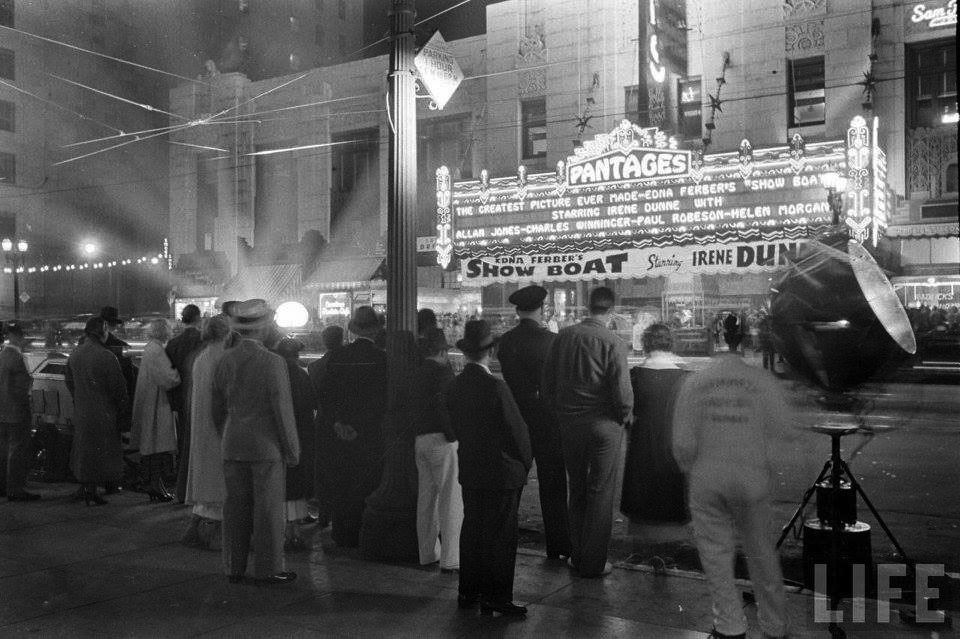 |
|
| (1936)+#+ – Life Magazine photo showing a crowd gathered across Hollywood Boulevard from the Pantages Theatre as Universal Pictures hold a whiz-bang premiere for “Show Boat”. Notice how the marquee claims it is “The Greatest Picture Ever Made”. |
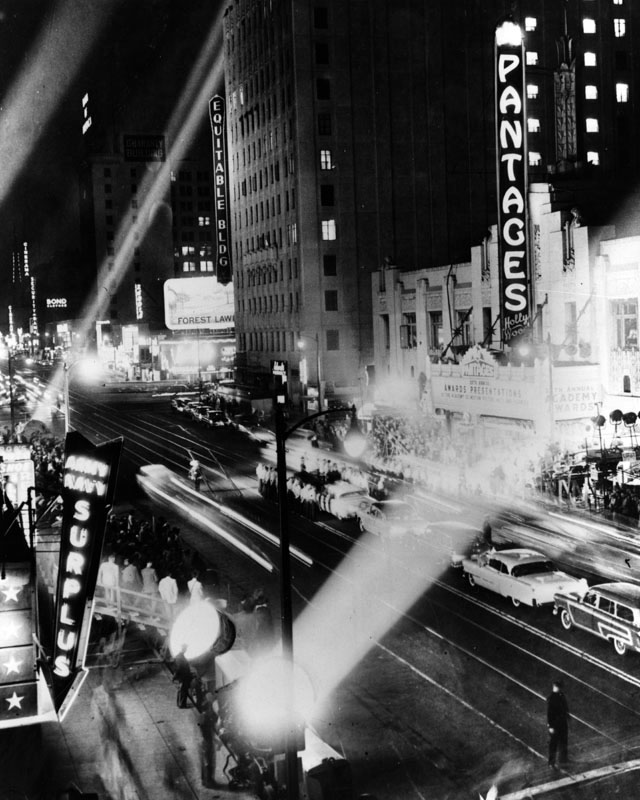 |
|
| (1950)* - Exterior view of the Pantages Theatre during the 20th Annual Academy Awards. Crowds of people are seated in bleachers directly outside the theater and on the south side of Hollywood Blvd. A line of cars is seen in the middle of the boulevard. Various signs identify neighboring buildings and businesses: Army Navy store, the Equitable Building, Bond Clothiers, Bank of America, Cinerama and the Guaranty Building. Street car tracks are visible on the street. |
Historical Notes From 1950 to 1960, the awards were presented at Hollywood's Pantages Theatre. The 22nd Academy Awards Ceremony awarded Oscars for the best in films in 1949. This was the last year for which all five Best Picture nominees were in black and white.*^ Best Picture: All the King's Men Best Actor: Broderick Crawford – All the King's Men Best Actress: Olivia de Havilland – The Heiress |
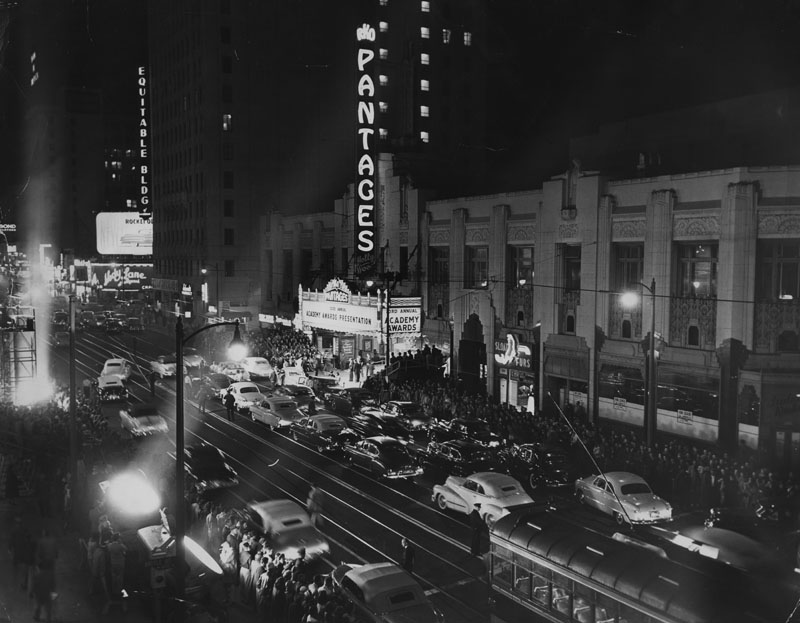 |
|
| (1951)* - The 23rd Annual Academy Awards at the Pantages Theatre in Hollywood. |
Historical Notes The 23rd Academy Awards Ceremony awarded Oscars for the best in films in 1950. The nominations were notable this year, as All About Eve was nominated for fourteen Oscars, beating the previous record of thirteen set by Gone with the Wind.*^ 23rd Annual Academy Awards (March 29, 1951): Best Picture: All About Eve Best Actor: José Ferrer – Cyrano de Bergerac Best Actress: Judy Holliday – Born Yesterday |
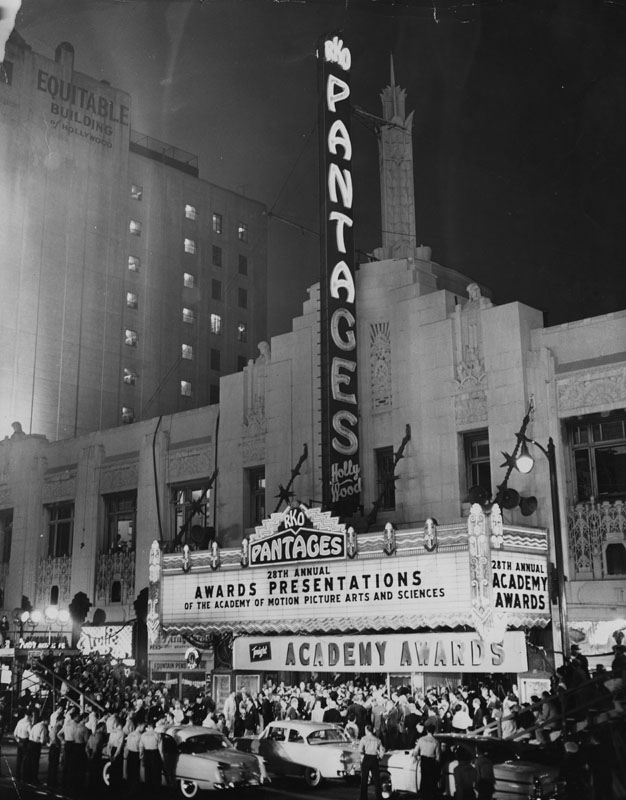 |
|
| (1956)* - View of the crowd gathered in front of the Pantages Theater in Hollywood to watch the stars come out for the Academy Awards. More than 10,000 gathered in front of the famed theater on March 21, 1956, to cheer their favorites. More than 90 regular and reserve policemen were needed to keep the crowd in order. |
Historical Notes The 28th Academy Awards, saw, Marty, a simple and low-budget film usually uncharacteristic of Best Picture awardees, became the shortest film (as well as the second Palme d'Or winner) to win the top honor.*^ 28rd Annual Academy Awards (March 21, 1956): Best Picture: Marty Best Actor: Ernest Borgnine – Marty Best Actress: Anna Magnani – The Rose Tattoo |
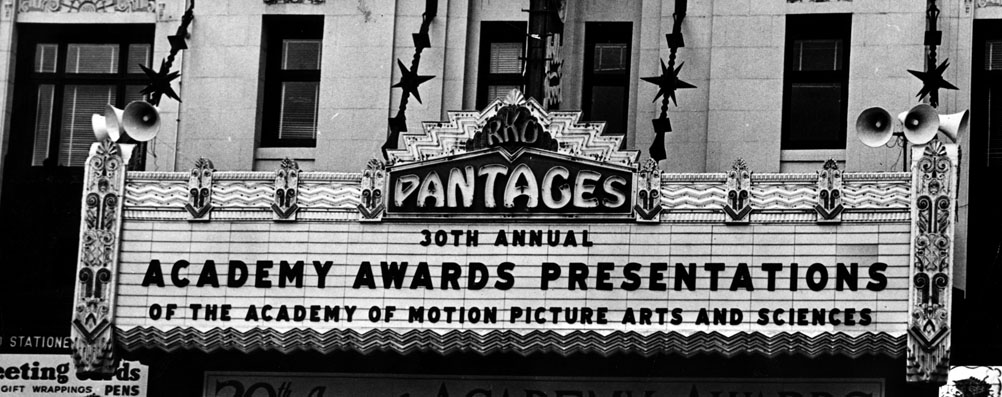 |
|
| (1958)* - 30th Annual Academy Awards at the Pantages Theatre. |
Historical Notes 1957's best films were honored at the 30th Academy Awards. The Oscar for Writing Based on Material From Another Medium was awarded to Pierre Boulle for The Bridge on the River Kwai, despite the fact that he did not know English. The actual writers, Carl Foreman and Michael Wilson were blacklisted at the time and did not receive screen credit for their work. Foreman and Wilson have since been acknowledged by the Academy for their contributions. Joanne Woodward's win for Best Actress for her triple role as Eve White, Eve Black and Jane in The Three Faces of Eve marked the film as the last film to win Best Actress without being nominated for other awards. This was broken 31 years later when Jodie Foster won Best Actress for her role in The Accused, the film's only nomination. Peyton Place tied the record for the most nominations without a single win (9) with The Little Foxes. It would not be broken until 1977 when The Turning Point received 11 nominations without a win, which has not been broken since, though The Color Purple subsequently tied the record. Peyton Place also set the record for most unsuccessful acting nominations with five; this record has been tied once, by Tom Jones at the 36th Academy Awards. It was the first time the ceremonies were broadcast live.*^ 30th Academy Awards (March 26, 1958): Best Picture: The Bridge on the River Kwai Best Actor: Alec Guinness – The Bridge on the River Kwai Best Actress: Joanne Woodward – The Three Faces of Eve |
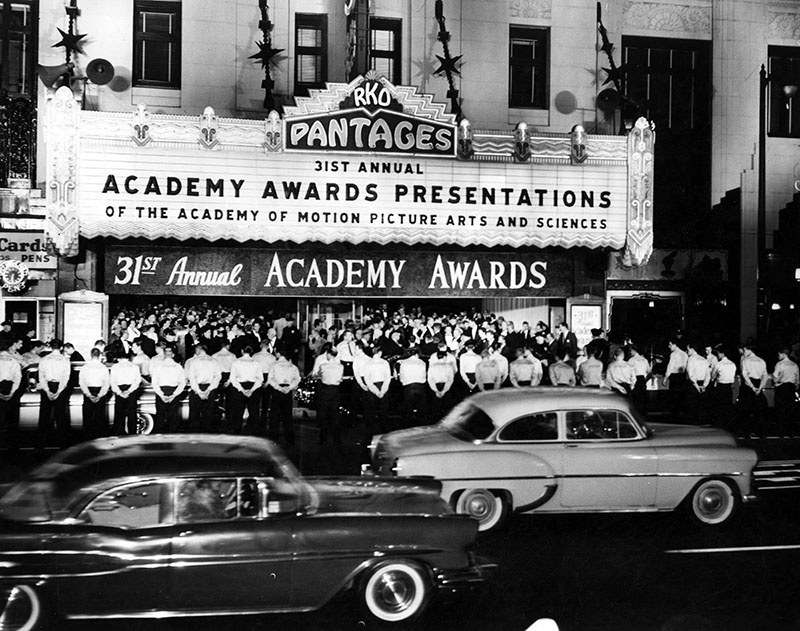 |
|
| (1959)* - Photograph caption dated April 7, 1959 reads, "Theater lobby packed - Here at the last moment, crowds of ticket holders make a rush for the Hollywood Pantages door in anticipation of the two-hour telecast of the Academy of Motion Picture Arts and Sciences' 31st annual awards presentation. More than 100 famed stars were on hand to regale the packed audience.". |
Historical Notes The 31st Academy Awards ceremony was held on April 6, 1959, to honor the best films of 1958. The show's producer, Jerry Wald, started cutting numbers from the show to make sure it ran on time. Unfortunately, he cut too much material and the ceremony ended 20 minutes early, leaving Jerry Lewis to attempt to fill in the time. Eventually, NBC cut to a re-run of a sports show. The film Gigi won nine Oscars, breaking the previous record of eight (set by Gone with the Wind and tied by From Here to Eternity and On the Waterfront). It would be shortlived, however, as Ben-Hur broke the record with eleven Oscars the following year.*^ 31st Annual Academy Awards (April 6, 1959): Best Picture:Gigi Best Actor: David Niven – Separate Tables Best Actress: Susan Hayward – I Want to Live! |
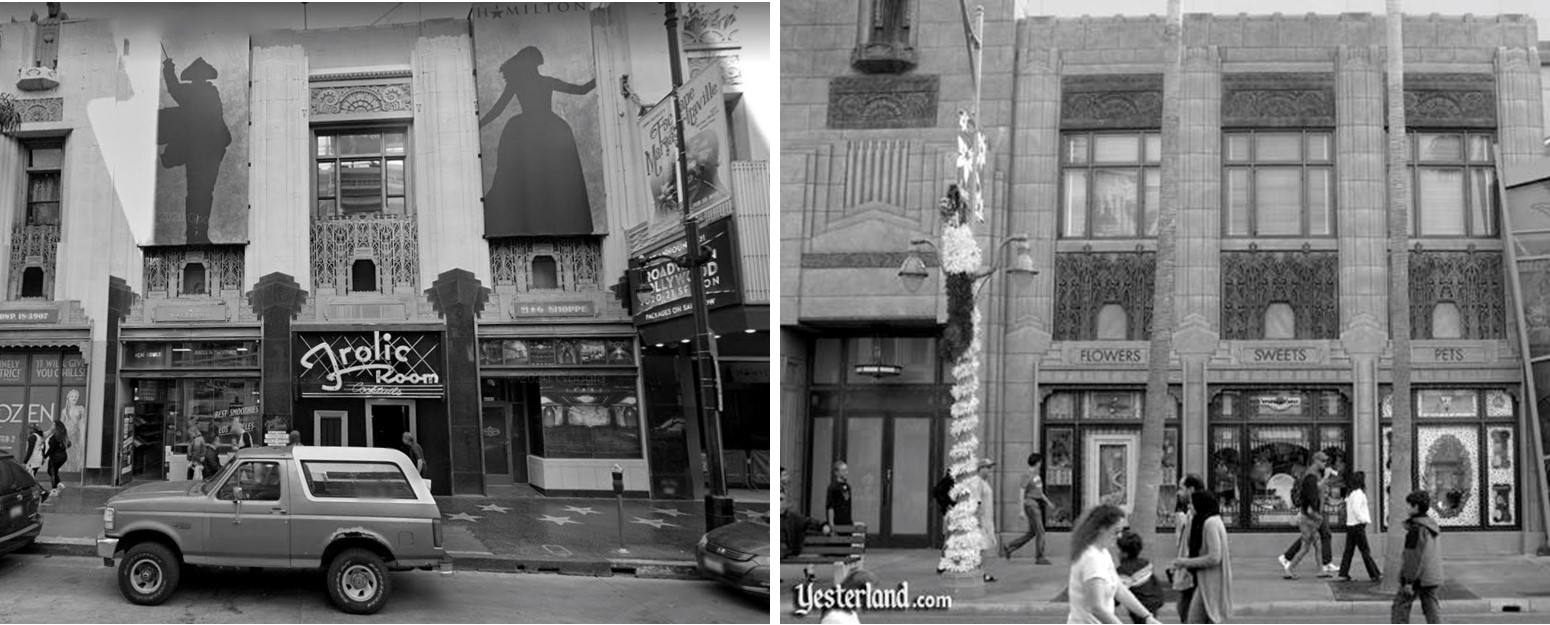 |
|
| (2008)^v^ –On the right is Disney’s Hollywood Studios Backlot façade based on the Pantages Building design as seen to the left. |
Historical Notes The Hollywood Pictures Backlot façade with its signs, “Flowers, Sweets, Pets,” is based on the famed Pantages Theatre in Hollywood—but only the part of the Pantages that’s to the left of the theater’s entrance and marquee, which is why the Disney version doesn’t look like a theater. |
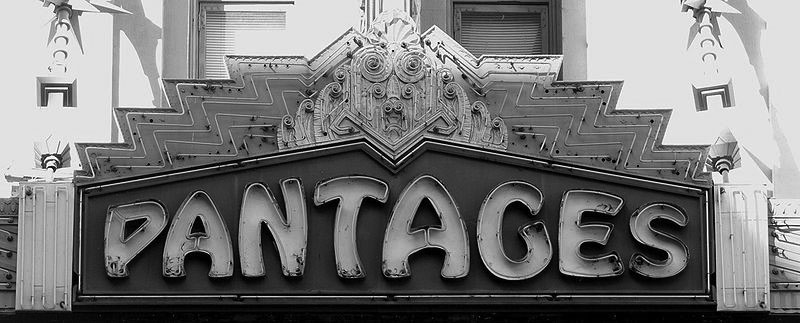 |
|
| (2008)*^ - Close-up view of the Pantages Theatre neon sign above the entrance to the Pantages Theatre. |
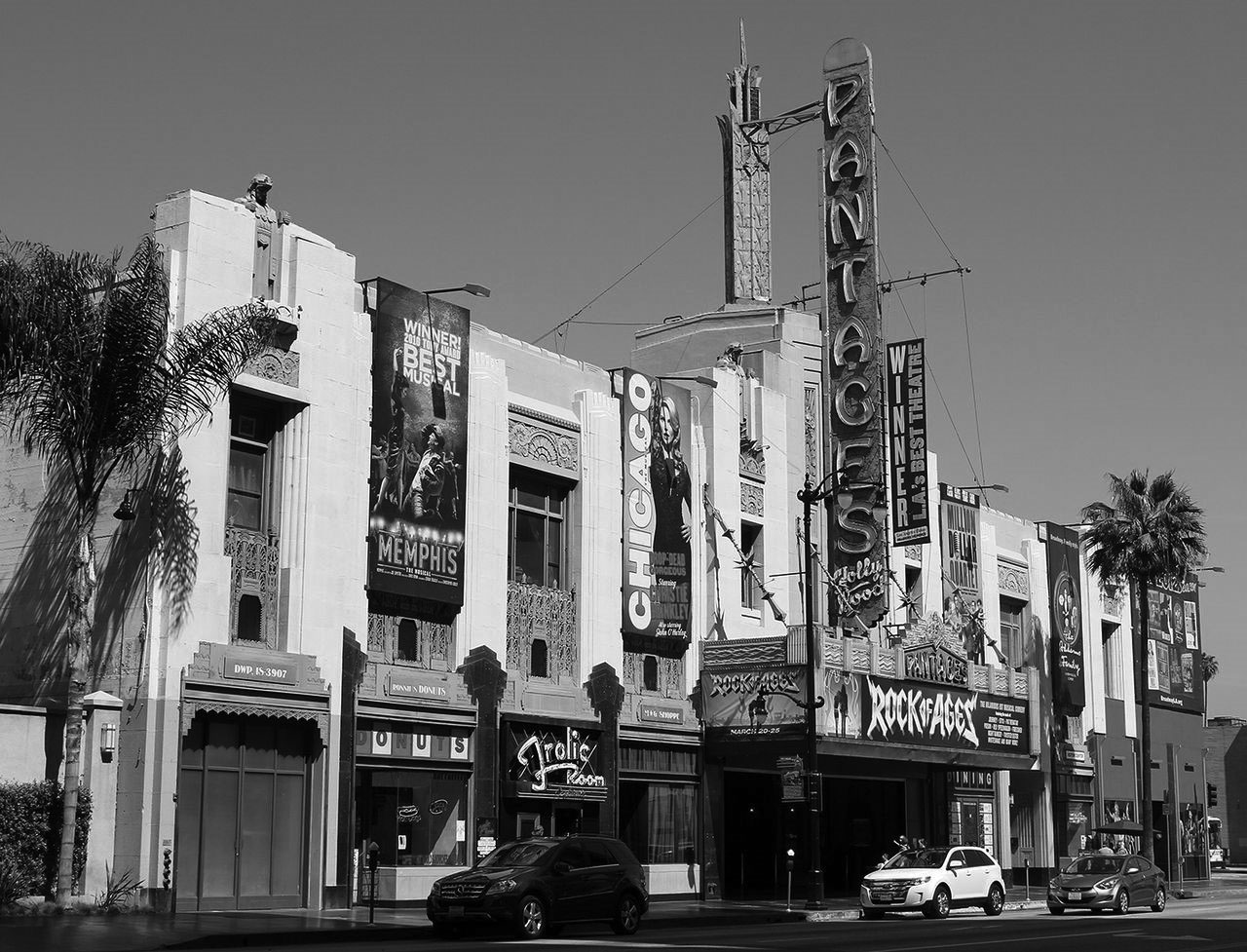 |
|
| (2012)*^ – View of the Pantages Theatre with the Frolic Room seen just left of the entrance. |
Historical Notes The Frolic Room, located next door to the Pantages Theater is one of the most historic and quintessential dive bar in Hollywood. This watering-hole has gone through a variety of permutations over the years. It began serving as a private speakeasy lounge originally called Freddy’s, then opened to the public in 1934, as Bob’s Frolic Room. The Frolic Room was reputedly the last place the real Black Dahlia, Elizabeth Short, was seen alive. Both Frank Sinatra and Judy Garland also imbibed here. Howard Hughes owned both the Pantages and the bar from 1949 to 1954. He added the colorful, artistic neon bar sign above the door that still welcomes patrons today, as well as throwing lavishly wild parties.^ |
 |
|
| (2014)* – Pantages Theatre marquee reads "The Book of Mormon". Photo by Adrian Scott Fine - LA Conservancy |
Historical Notes In 2000, the theater underwent a massive rehabilitation project, uncovering its Art Deco grandeur, receiving a Conservancy Preservation Award in 2001. |
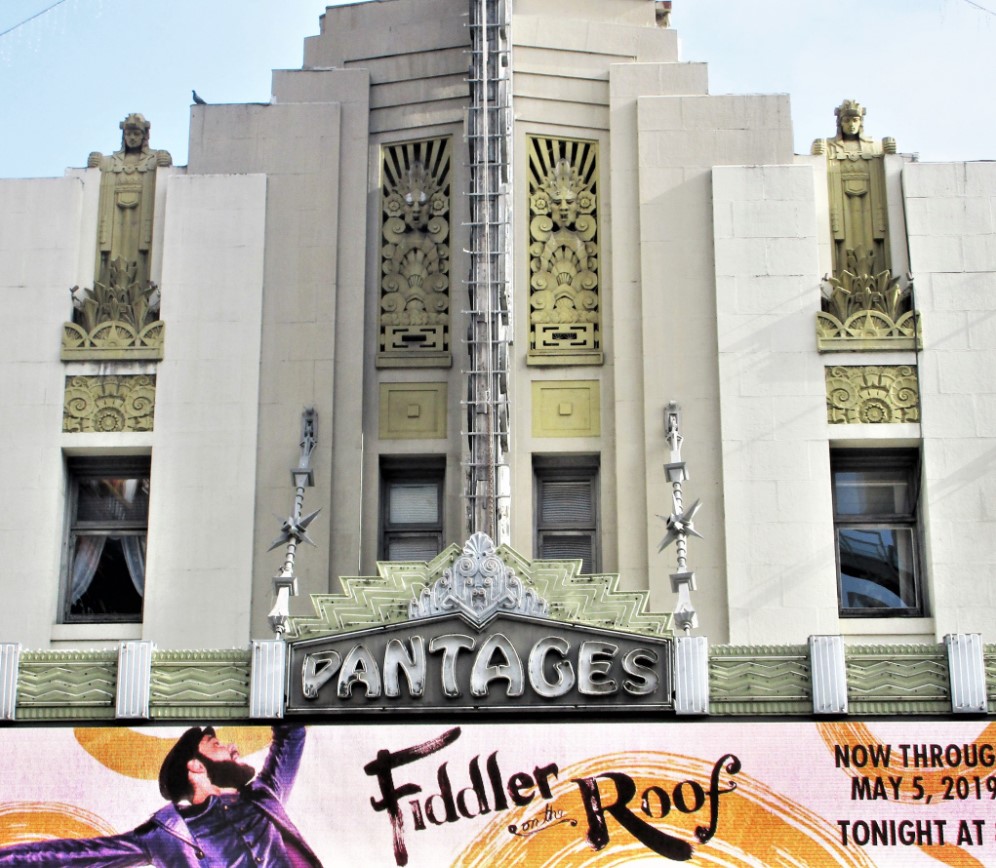 |
|
| (2019)^.^ – Pantages Theatre marquee reads "Fiddler on the Roof". Photo by Howard Gray |
Historical Notes Now operated by a subsidiary of The Nederlander Organization, the fully-restored Pantages is one of the city’s highest-grossing venues for live stage and Broadway-style productions, packing in audiences for such lavish hits as The Lion King, Wicked, The Book of Mormon, Fiddler on the Roof, and Hamilton. With a location a few steps from “Hollywood and Vine,” a major hotel complex and a subway station directly across the street, and numerous development projects newly-announced or underway, the best years of the Pantages may well lie in the future.^ |
* * * * * |
|
Other Sections of Interest |
|
Water and Power in Early LA |
|
Newest Additions |
New Search Index |

A new SEARCH INDEX has been added to help navigate through the thousands of topics and images found in our collection. Try it out for a test run.
Click HERE for Search Index |
* * * * * |
< Back
Menu
- Home
- Mission
- Museum
- Major Efforts
- Recent Newsletters
- Historical Op Ed Pieces
- Board Officers and Directors
- Mulholland/McCarthy Service Awards
- Positions on Owens Valley and the City of Los Angeles Issues
- Legislative Positions on
Water Issues
- Legislative Positions on
Energy Issues
- Membership
- Contact Us
- Search Index
© Copyright Water and Power Associates
Layout by Rocket Website Templates